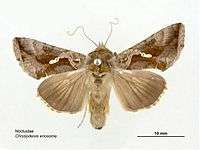Chrysodeixis eriosoma
| Green Garden Looper | |
|---|---|
 | |
| Scientific classification | |
| Kingdom: | Animalia |
| Phylum: | Arthropoda |
| Class: | Insecta |
| Order: | Lepidoptera |
| Family: | Noctuidae |
| Genus: | Chrysodeixis |
| Species: | C. eriosoma |
| Binomial name | |
| Chrysodeixis eriosoma (Doubleday, 1843) | |
| Synonyms | |
|
Plusia eriosoma Doubleday, 1843 | |
The Green Garden Looper (Chrysodeixis eriosoma) is a moth of the family Noctuidae. Mostly cosmopolitan distribution, it is a serious pest found throughout Wadelai, Aden, Japan, China, throughout the Indian, Sri Lanka, Malayan, and Australasian regions.[1] It is present in Hawaii and recorded as an incursion in mainland North America and Russia.[2]
Description
Adult


Chrysodeixis eriosoma has a wingspan of 42 mm.[1] The adult moth is dark grey-brown, with bunched hairs on its thorax that look like a short pair of horns. Males have long orange hair-like scales on either side of the abdomen, which are distinctive for this species, and these are probably the origin of the scientific name, as in Greek, erith = red, and soma = body. On each forewing of males and females is a silvery figure of eight with the two halves separated, unlike the related species C. subsidens in which they are fused together. The absence of a tiny silver 's' on the fore wings distinguishes it from another related species, C. argentifera. The chemical identities of the sex attractants (Pheromones) for this moth have been elucidated.[3] Some specimens are much darker than others.[1]
Chrysodeixis eriosoma differs from C. signata in the head, thorax, and fore wing having a reddish tinge; abdomen with the lateral and anal tufts often black in the male. Fore wing with much more gilding on the basal, medial, and outer areas; the antemedial line more oblique, the postmedial more oblique and sinuous; the Y mark large, prominent, and golden, the arms often filled in with golden and occasionally joined to the tail.[1]
Chrysodeixis eriosoma and Chrysodeixis chalcites moths cannot be separated morphologically, and they may be sibling species. However, they may be distinguished based on DNA sequencing, pheromones, or geographic origin as C. chalcites is found in the Palearctic and C. eriosoma in the tropical and subtropical regions of eastern Asia and the Pacific islands as well as in Australia and New Zealand. The literature referring to C. chalcites in southern and eastern Asia or Oceania may actually refer to C. eriosoma.[4]
Larva
The larvae are green with a number of faint longitudinal dorsal and lateral white lines. They also sometimes have black dots on their sides. As for most other plusiine, they lack two pair of prolegs and thus move in a looper fashion, which is somewhat similar to caterpillars in the family Geometridae. They grow to a length of about 4 cm.[3] They are polyphagous and have been reported to feed on over sixty species of plants.[1][5]
Life cycle
Duration of the pupal stage varies from a few days in summer to about a month in winter.[3]
References
| Wikimedia Commons has media related to Chrysodeixis eriosoma. |
| Wikispecies has information related to Chrysodeixis eriosoma |
- 1 2 3 4 5 G. F. Hampson (1895) The Fauna of British India including Ceylon and Burma, Moths Vol. II
- ↑ CABI Invasive Species Compendium Datasheet: Chrysodeixis eriosoma (green looper caterpillar) (Viewed 14 Nov. 2015)
- 1 2 3 Coffs Harbour Butterfly House, Maze and Tearooms
- ↑ "The Food and Environment Research Agency – Rapid Pest Risk Analysis for Chrysodeixis chalcites".
- ↑ "Plantwise Knowledge Bank - Plantwise Technical Factsheet - green looper caterpillar (Chrysodeixis eriosoma)".